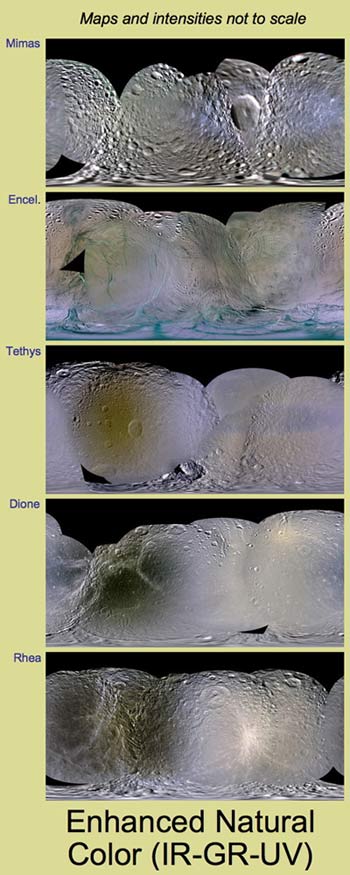Mysterious Patches of Color Mapped on Saturn's Moons

New maps reveal colorful patterns on the surfaces ofSaturn's five innermost icy moons.
Some of the patterns have been seen before, but others tookscientists by surprise, suggesting dynamic interactions between themoons and other particles orbitingaround Saturn.
The maps of Mimas, Enceladus, Tethys, Dione, and Rhea werecreated from images taken by NASA'sCassini spacecraft and were presented by Paul Schenk of Houston?s Lunar andPlanetary Institute at a recent meeting of the American Astronomical Society.
Surface redness
Some of the most striking patterns are revealed when thebrightness of the surface in infrared light is divided by the brightness in theultraviolet part of the spectrum, which gives the so-called redness of thesurface. The maps reveal that except for Mimas, all the inner moons are redder ontheir trailing hemispheres.
This reddening is strongest at the centers of the trailing face(like the center of a bulls-eye). The leading faces of the moons also appear tobe redder in their centers, though the redness is weaker than for the trailinghemisphere.
Seeing this pattern on both hemispheres is difficult toexplain because most processes that would color the surface in this way wouldonly affect one hemisphere or the other.
Get the Space.com Newsletter
Breaking space news, the latest updates on rocket launches, skywatching events and more!
Possible explanations include bombardment by grains in Saturn's Ering, which would impact the leading hemisphere as the satellites over tookthe grains in their orbit, and radiation by charged particles. The latterexplanation could favor the trailing hemispheres of the moons, as they areheavily bombarded by cold plasma, or the leading hemispheres, which areimpacted by high-energy electrons.
Bands and splotches
One curious feature, seen before in Voyager observationsnearly 30 years ago, was the dark equatorial lens-shaped band across thefront-side of Tethys. This feature is very prominent in the new Cassini colormaps and appears bright in the ultraviolet end of the spectrum, but dark atinfrared wavelengths.
An unexpected discovery is that Mimas also has a prominentequatorial lens-shaped band about 175-kilometers wide stretching across itsleading side as well.
Scientists are investigating the cause of these bands; onepossible explanation is the impact of high-energy electrons, which is predictedto produce such a feature. A similar process has been investigated forJupiter?s moon Europa, where the same energy particles preferentially impactthe trailing hemisphere.
Another surprise was the discovery of a very narrow andstraight band of discrete ultraviolet-bright features very close to Rhea?sequator. At higher resolution, the band appears as bluish splotch-marks thatform a very narrow chain only a few kilometers wide across the center of the leadinghemisphere of Rhea. These features are seen on no other icy satellite ofSaturn.
The pattern of the splotches suggests they are the result ofimpacts from Rhea's dustyring system, first proposed in 2008.
Researchers hope that these maps will help them betterunderstand the dynamics of the particles in orbit around Saturn as the Cassinimission continues. Higher resolution maps could also help better understand howthe particles might play a part in making the patterns revealed by the newmaps.
- Video ? Cassini's Crossing
- Images: Cassini Explores Saturn's Moons
- Cassini's Greatest Hits: The Best of Saturn
Join our Space Forums to keep talking space on the latest missions, night sky and more! And if you have a news tip, correction or comment, let us know at: community@space.com.

Space.com is the premier source of space exploration, innovation and astronomy news, chronicling (and celebrating) humanity's ongoing expansion across the final frontier. Originally founded in 1999, Space.com is, and always has been, the passion of writers and editors who are space fans and also trained journalists. Our current news team consists of Editor-in-Chief Tariq Malik; Editor Hanneke Weitering, Senior Space Writer Mike Wall; Senior Writer Meghan Bartels; Senior Writer Chelsea Gohd, Senior Writer Tereza Pultarova and Staff Writer Alexander Cox, focusing on e-commerce. Senior Producer Steve Spaleta oversees our space videos, with Diana Whitcroft as our Social Media Editor.









